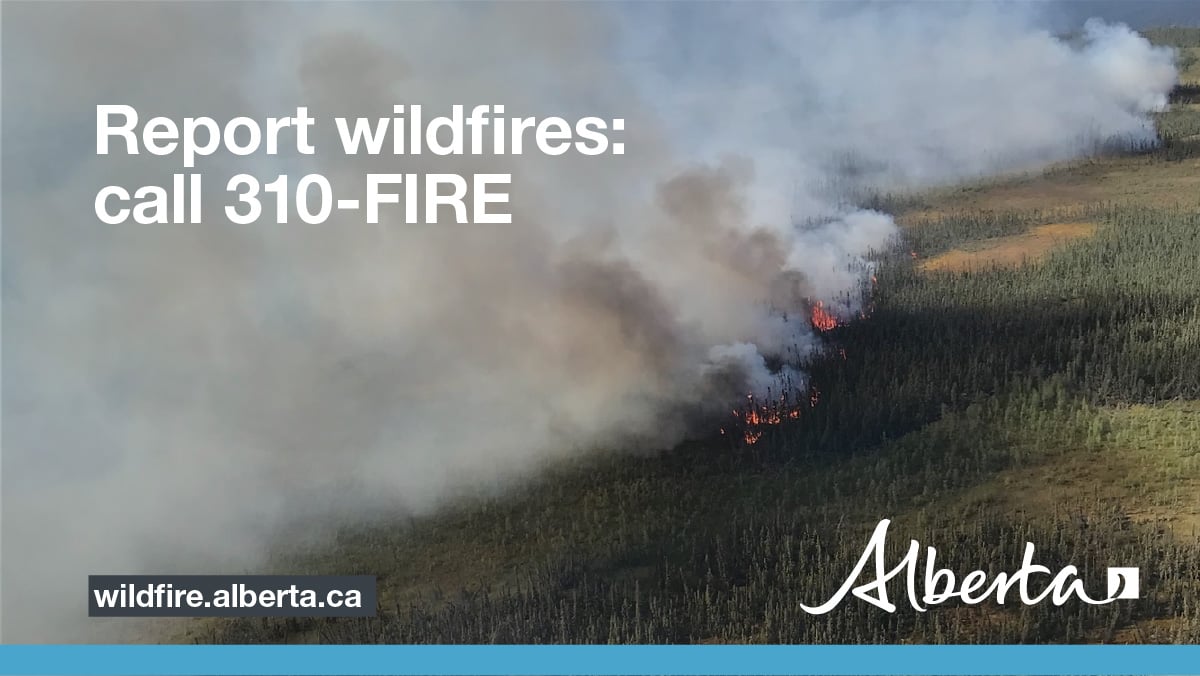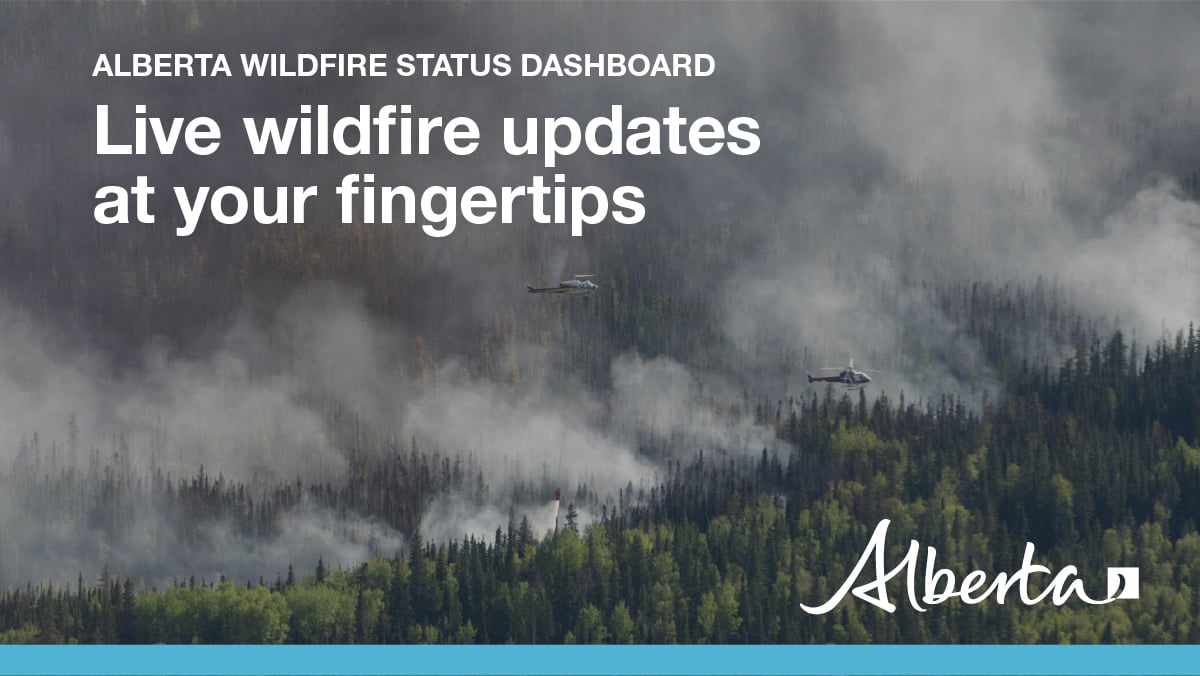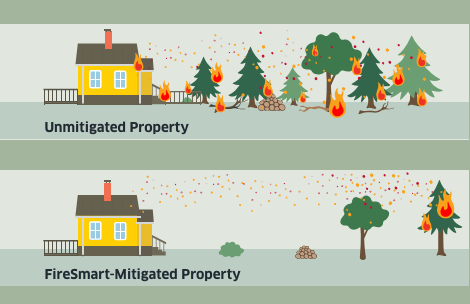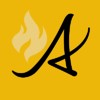
Wildfire danger
The wildfire danger in the Slave Lake Forest Area is EXTREME. Firefighters urge everyone to use caution when working or recreating outdoors, as under the hot and dry conditions, a fire will ignite easily and spread rapidly.
Report wildfires immediately by calling 310-FIRE (3473).

On Alert
With expected lightning activity, new wildfires may occur. Fire lookouts are watching for smoke and firefighters with helicopters, airtankers and heavy equipment are ready to respond to any new wildfires that start.

Weather
For Tuesday, the high will be 25-27 degrees and the winds will be from southeast 20 kilometres per hour in the morning. In the early afternoon the winds will switch and come from the west/southwest at 20 kilometres per hour gusting up to 50. Scattered showers and thunderstorms are expected.

Photo: Smoke forecast for July 22, 2024 2:00 pm
Smoky conditions
Due to the wildfire activity smoky conditions will persist in the Slave Lake Forest Area. Visit www.firesmoke.ca to see where the smoke is coming from. Anyone with health concerns should visit Alberta Health Services or call 811 for health advice from Alberta Health Link.

A fire ban is in effect for the entire Forest Protection Area of Alberta, including the Slave Lake Forest Area, due to hot and dry conditions.
Under this fire ban:
All fire permits are suspended or cancelled and no new fire permits will be issued. Some allowances can be made for essential agricultural and industrial burning, if approved by a forest officer.Prohibited:
-
All outdoor wood fires, including wood campfires on public land, private land, designated campgrounds, and backyard firepits
-
Barbeque charcoal briquettes
-
Fireworks and exploding targets
Allowed:
-
Propane/ natural gas-powered appliances
-
Indoor wood fires inside a structure (such as a facility, building, tent or RV) and contained within a device with a chimney and spark arrestor
-
Open flame oil devices (such as deep fryers and tiki torches). All devices must be CSA approved and used per manufacturer’s standards.
- Off-highway vehicle use is allowed.
The fire ban will remain in effect until conditions improve. Firefighters appreciate your cooperation. By following the fire ban you help firefighters stay focused on fighting the current wildfires and responding to new wildfires, instead of responding to smokes from campfires.
For more information view the Fire ban factsheet
The town of High Prairie, town of Slave Lake, and the Big Lakes County Fire Permit Area have also issued a fire ban. For specific fire ban information visit www.albertafirebans.ca

Current wildfire situation
Currently, in the Slave Lake Forest Area, there are eight wildfires classified as burning out of control, two being held and five under control.
SWF120 was detected on the afternoon of July 14 and is located approximately 23 kilometres northwest of Chipewyan Lakes. The wildfire is classified as burning out of control and is 12,625 hectares in size. Today, the winds were light and from the north/northeast. The wildfire did experience some growth on the south end towards the west. The growth was not significant. For tomorrow, as soon as visibility improves airtankers will be requested.
Rabbit Lake Complex which includes MWF060, MWF078 are located approximately 36 and 24.5 kilometres northeast and east of Chipewyan Lakes. Both wildfires are classified as burning out of control. MWF060 is 20,219 hectares in size and MWF078 is 2,592 hectares. Due to poor visibility firefighters were unable to assess these wildfires today. Based on satellite imagery, the wildfires did not experience significant growth or spread today.
Map SWF120 and Rabbit Lake Complex
Due to multiple wildfires burning northwest, northeast and east of Chipewyan Lakes the MD of Opportunity has issued an Alberta Emergency Alert for the community of Chipewyan Lakes.
SWF124 is located in the Marten Hills and is approximately 30 kilometres southwest of Bigstone Cree Nation Wabasca 166D and approximately 47 kilometres northeast of Slave Lake. SWF124 is classified as burning out of control and is 7,196 hectares in size.
Today, with southeast winds there was some growth on the northwest corner of the wildfire. The growth was moving to the northwest and is approximately 17 kilometres southeast of Highway 754.
In anticipation of winds coming from the west/northwest tomorrow, airtankers worked on an active part in the southeast portion of the wildfire this afternoon. Heavy equipment is building fire guard along this area and firefighters continue to work on the south end of the wildfire, securing the fire guard by extinguishing hotspots 30 metres into the wildfire.
Tomorrow, there will be 50 firefighters, three helicopters and six heavy equipment groups working on the wildfire. Airtankers will be requested as soon as visibility improves.
At this time, SWF124 does not pose a risk to communities or highway 754.
For your safety do not enter into active wildfire areas.

SWF130 was detected July 18 and is located approximately 90.7 kilometres northwest of Red Earth Creek. The wildfire is classified as burning out of control and is 1,633 hectares. This wildfire will be monitored by aircraft when visibility permits.
SWF129 was detected July 18 and is located approximately 88 kilometres northwest of Red Earth Creek. The wildfire is classified as burning out of control and is 6,400 hectares in size. This wildfire will be monitored by aircraft when visibility permits.
SWF128 was detected on July 18 and being held at 0.1 hectares.
SWF126 is located approximately 17 kilometres northeast of Swan Hills. The wildfire is 0.23 hectares and is being held.
SWF106 was detected on July 12 and is located approximately 60 kilometres north of Red Earth Creek. The wildfire is under control and is 4.8 hectares in size. Tomorrow, nine firefighters will be patrolling to confirm SWF106 is extinguished.
SWF103 was detected on July 11 and is located approximately 36 kilometres southwest of Trout Lake. The wildfire is classified as under control and is 10.2 hectares in size. Tomorrow, there will be nine firefighters patrolling to confirm this wildfire is extinguished.
SWF101 was detected on July 11 and is located approximately 47 kilometres northwest of Red Earth Creek. It is estimated to be 90 hectares in size and is classified as burning out of control. Tomorrow, there will be 25 firefighters with a helicopter working on this wildfire.
SWF096 and SWF098 are located approximately 33 kilometres north of Red Earth Creek on the west side of Highway 88. These wildfires are both under control and are 73.2 and 80.4 hectares in size. Tomorrow, there will be 17 firefighters with a helicopter working on these wildfires.
SWF095 is located approximately 70 kilometres north of Peerless Lake. It is estimated to be 2,083 hectares in size and is classified as burning out of control. This wildfire will be monitored by aircraft when visibility permits.
SWF092 and SW093 are located approximately 85 kilometres north of Red Earth Creek. The wildfires are three and 2,421 hectares in size and are classified as burning out of control. These wildfires will be monitored by aircraft when visibility permits.
SWF076 was detected on July 9th and is located approximately 82 kilometres northwest of Red Earth Creek. The wildfire is under control and is 44 hectares in size. Eight firefighters will be patrolling to confirm the wildfire is extinguished.
Since January 1, 2024, 133 wildfires have been reported in the Slave Lake Forest Area, resulting in a total burned area of 30,037.6 hectares.
Since January 1, 2024, 933 wildfires have been reported in the Forest Protection Area of Alberta, resulting in a total burned area of 524,555.17 hectares.
To view wildfires on a map, download the AB Wildfire App or visit the Alberta Wildfire Status Dashboard
The Forest Protection Area is divided into 10 forest areas. Find the latest updates for each area here or subscribe to receive them in your inbox.

Prevent wildfires
67% of wildfires in Alberta are caused by people. Whether you are recreating or working outdoors, please do your part to prevent wildfires.
When riding your off-highway vehicle, stop frequently to remove any build-up of debris from your machine. Grass, muskeg, moss or other debris can begin to smoulder and drop to the ground as you're riding and spark a wildfire. Always carry firefighting equipment such as a shovel, extinguisher and bucket when you ride.

FireSmart Alberta
If you have any questions, please contact:
Wildfire Information Officer
Leah Lovequist
Mobile:780-849-0945
Leah.Lovequist@gov.ab.ca
RELATED INFORMATION
Forest Area Updates:
Websites:
